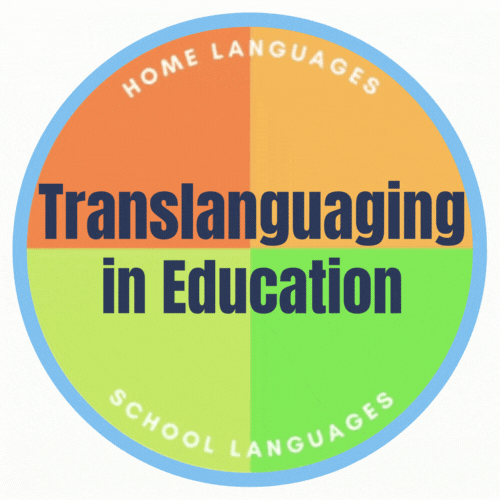
Translanguaging Activities
TL strategies consist of four different states:
Static Top Alone; Spinning Top Alone; Static Top Together; Spinning Top Together.
Static Top Alone strategies represent the activities when a teacher or a student uses one language at a time alone. In many cases teachers do not speak the HLs of minority students and have no other choice but to use only the SL. Students also often have to use only the SL when showing their knowledge in spoken or written form unless someone else, such as a friend, can interpret his or her HL performance in the SL. For bilingual learners or teachers, however, using two languages at the same time is more common unless a single language use policy is strongly imposed on them. Even if students are prohibited from using their HL, they often ‘smuggle in’ their HL in the classroom.
Spinning Top Alone strategies represent activities that allow learners to use their all of language resources, such as looking up words in a bilingual dictionary, using key terms of SL in home language default sentences, prewriting in either language and writing in the other language, and so on.
Static Top Together represents the activities when students are using only one language at a time for their small group or classroom work. These cases are found more often among bilingual students at lower grades of primary school when their performance level in the SL is still very low and when they mainly have to use their HL and also among monolinguals whose home language and school language are identical. They learn better within the space between what they can do alone and what they can do with their friends or teacher with more knowledge. This space is called the Zone of Proximal Development (ZPD) and learning occurs in this ZPD (Vygotsky, 1978, p.86). If monolingual learners learn better within their ZPD, the same is true for bilingual learners, but only when they are allowed to use all of their bilingual resources within a Bilingual Zone of Proximal Development (BZPD) (Moll and Dias, 1987).
If bilingual students are forced to use only their SL, they cannot fully show their true knowledge until their SL is fully developed. Thus, various activities of Spinning Top Together are crucial for bilingual students to learn better as they can leverage all of their language resources from both their SL and HL to learn academic content and develop each of their languages as they work together.
Performance levels tend to differ according to the different states of TL top. In the case of the Static Top, where the language that students are allowed to use in the classroom is their weaker language as in the case of minority students using Thai or English at their low primary grades, the students’ performance level for each state of the TL top is most likely to decrease in the left to right descending as in the figure above. When students are allowed to use only their SL while their performance level in the SL is still lower than their performance in their HL, they are likely to perform the best when they work together with peers using all of their language resources (Spinning Top Together), followed by when they work alone using all of their language resources (Spinning Top Alone), when they work together using only the SL (Static Top Together), and when they work alone using only the SL (Static Top Alone) where they are likely to perform the worst.
This was demonstrated during the five different TLE workshops held in Chiangmai, Thailand from June 2020 till January 2021. The participants in the workshops such as teachers, principals, education supervisors, etc. were asked to write a story in English, in their weaker language, based on their observation of a village picture of their students in the following order: writing in English alone (Static Top Alone); writing in English together with their peers but using only English while discussing about what to write (Static Top Together); writing in English with the help of Google Translate and the Internet for looking up unfamiliar words (Spinning Top Alone); and lastly writing in English with their peers utilizing all of their language resources (Spinning Top Together). As expected, the length and richness of their story was found to be in the descending order from Spinning Top Together to Spinning Top Alone, then Static Top Together to Static Top Alone as shown in the picture above. All the participants had an indirect opportunity to imagine that their students must have the same challenge as themselves and started designing the kinds of strategies of Spinning Top Alone and Together for teaching their students.
Currently, what is missing in most schools are TL activities of Spinning Top Alone and Spinning Top Together, thus enabling bilingual students to learn on the sloped playing field of education. Teachers may begin their instruction with static top alone strategies while using SL. However, once they realize that the students find their Static Top Alone instruction challenging due to less understanding and development of their SL, they should design the lesson in ways that the bilingual students could utilize their whole language resources including their home language whether alone or together with other peers who have the same HL background. It is when bilingual students have chances to use all of their language resources that the education playing field becomes level. Some successfully implemented examples of TL strategies of Spinning Top Alone and Together are introduced in the four links below.


Static top alone activities are those during which an individual student or a teacher uses only one language. The teacher is likely to use the school language when he or she explains content while students can use either the school language or their home language for various purposes of learning. An individual student, for example, can read a book in the school language or do a monolingual worksheet alone.

Static top together activities are those during which the teacher and students interact together using the school language or when students work together using only one language. For example, a group of students or a pair of students present their group work before the class using the school language so that both the teacher and students from other home language backgrounds can understand.

Spinning Top Alone activities are those during which an individual student is using all of their language resources, such as both school and home languages together. A student, for example, uses bilingual dictionary or glossary, does a multilingual worksheet, or pre-writes in a language and writes in another language.

Spinning Top Together activities are those where students with the same home language background work together using all of their language resources including the same home language feature as a part of all of their language resources. Students can learn best and show their true knowledge when encouraged to utilize all of their language resources.
